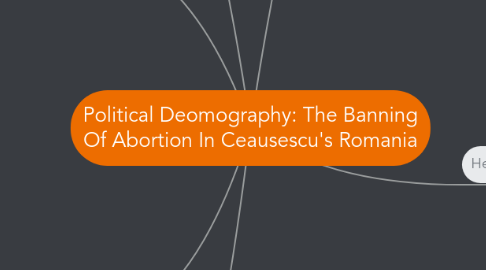
1. Pronatalist Policies
1.1. The Constitution of the Socialist Republic of Romania (SRR)
1.1.1. Granted all citizens the right to work as well as equal pay for equal work
1.2. Law 770
1.2.1. Prohibited abortions unless if the mother is in danger
1.2.2. Due to this law in 1967, the birthrate flew up to 27.4%
1.2.2.1. 527,764 live births in 1967
1.2.2.2. 273,678 live births in 1966
1.2.3. Encouraged women to bear children
1.2.3.1. Financial allowances
1.2.3.2. Child support benefits
1.2.3.3. Maternity Leaves
1.2.3.4. Work Protection
1.3. Gilead (1980's)
1.3.1. Banning all forms of birth control, imposing pregnancy tests on women and linking promotion and wage increases to fertility
1.4. Response to the polices were characterized by ethnicity and class
1.5. Whoever didn't have children over the age of 25, wages were subtracted from their income
1.5.1. In order to avoid this monthly fee, many quit their jobs in order to work as migrant laborers
1.6. Cecusescu introduced a campaign (1986)
1.6.1. To analyze the health of the population
1.6.1.1. Between ages 16 and 45
1.6.1.1.1. When women are the most fertile
1.6.2. Many women had exams to seek control of their reproductive lives
1.6.2.1. Given trimester gynecological exams
1.6.2.1.1. Considered as a routine
2. Women
2.1. Social Assistance
2.1.1. Maternity Leaves
2.1.2. Job Security
2.1.3. Childcare Facilities
2.1.4. Maternity Leaves
2.2. Are A Minority
2.2.1. Positions of authority
2.2.2. Typically filled cultural or educational institutions
2.2.3. Women in the labor force were in the lower class and were poorly paid
2.3. Agricultural Labor
2.3.1. Flexible work schedules
2.3.1.1. Can work and also tend to their families
2.4. Gypsy Women
2.4.1. Do not practice abortion
3. Politics
3.1. Reproductive and abortion statistics are used as political tools in order to discipline the population
3.2. The altered anti-abortion law was used in order to punish both physicians and women
3.3. Illegal Abortions
3.3.1. There were many illegal abortions taking place. Many were punished by the government.
3.4. "At the same time, the legalization of abortion was not a policy decision made with socioeconomic and demographic aims, or long-term trends, in mind." (page 382)
3.5. President Illiescu signed a new adoption law which stopped baby trade (1991)
3.5.1. Law was introduced in order to protect citizens' rights
3.6. Romania's past experience with reproductive health can guide policymakers, health administrators and reproductive health professionals around the globe
3.7. "This study enables us to focus on the social implications and human costs of restrictive reproductive legislation and policies, especially as they affect the lives of women and children." (page 383)
4. Children
4.1. Adoption
4.1.1. National Adoption Commission (1990)
4.1.1.1. Foreigners would go to Romania in order to adopt children in need
4.1.1.1.1. Freed children from difficult living situations
4.1.2. Romanian families considered selling their children because they were in a desperate need for money
4.1.3. The private adoption process was a lot easier
4.1.3.1. The Romanian mother can change her mind and keep the child at any time
4.1.3.1.1. Women experience the emotional pain while giving away their child. They developed a tight bond during the child bearing stage.
5. Family Structure
5.1. Patriarchal
5.1.1. Male is the head of the household
6. Health
6.1. AIDS
6.1.1. Propaganda Campaign
6.1.1.1. Sex education increased through
6.1.1.1.1. Pre marital health counseling and check ups
6.1.1.1.2. Lectures
6.1.1.1.3. Films
6.1.2. Rise of Infant AIDS
6.1.2.1. International trafficking of babies through adoption
6.1.2.2. Abandonment
6.1.3. By 1992
6.1.3.1. 1,557 cases of AIDS have been recorded
6.1.3.2. AIDS cases are expected to rise due to poor hygiene in hospitals, drug trafficking and usage and prostitution
6.1.3.3. Many women with families became prostitutes to receive more money
6.1.3.3.1. Women had no respect for their bodies
6.2. Abortions
6.2.1. (1985) More strict abortions were put into place because of the falling birthrate
6.2.1.1. Women above 45 years old only can get an abortion
6.2.1.2. Can have up to 5 children in care, can have an abortion for others
6.2.2. Cost of an abortion
6.2.2.1. 2,000 to 10,000 lei (Approximately $160 to $830)
6.2.3. Legitimate Reasons For A Legal Abortion
6.2.3.1. Measles
6.2.3.2. Recurrent Fevers
6.2.3.3. Hepatitis
6.2.3.4. Turberculosis
6.2.3.5. Syphilis
6.2.3.6. Malignant Tumors
6.2.3.7. Diabetes
6.2.3.8. Taking medicines to cure such diseases were an excuse for abortions as well
6.2.3.8.1. Chemotherapy
6.2.3.8.2. Antimalarial Drugs
6.2.3.8.3. Anticonvulsants
6.2.4. Increase of Abortions
6.2.4.1. Between 1979 and 1988
6.2.4.1.1. Because of the deterioration of everyday life
6.2.4.1.2. Families were unable to feed their children
6.2.4.1.3. Law required them to have more children
6.2.5. Illegal Abortions
6.2.5.1. Between 1965 and 1989
6.2.5.1.1. 9,452 women died due to complications from the illegal abortion
6.2.5.2. 60.1% of the abortions performed in the hospital were incomplete
6.2.6. Abortions became legal again in Romania (1989)
6.2.6.1. Women feared about being pregnant
6.2.6.2. Abortions gave women control of their bodies once again
6.2.6.3. "Abortion, in this context, was understood as a fundamental aspect of the right to self- determination being articulated by republics and nationalities demanding their independence, as well by ethnic groups clamoring for recognition and respect." (page 380)
6.2.6.4. Bucharest Hospital (1990)
6.2.6.4.1. Reported 70 to 100 abortions daily
6.2.6.5. Romania needs to finance their funds into the development and distribution of contraceptives
6.2.6.6. Needed funds for AID research, treatment and education
6.2.6.7. Summer of 1991
6.2.6.7.1. Ratio of abortions to live births were 3 to 1
6.2.7. Women's ultimate form of contraception is an abortion
6.2.7.1. Hospitals raise their prices from 30 to 500 lei (500 lei is equivalent to around $2.50)
6.2.8. Banning of Abortions
6.2.8.1. Political interests
6.2.8.2. Religious interests
6.2.8.3. When abortions are illegal
6.2.8.3.1. Women resort to receive illegal abortions
